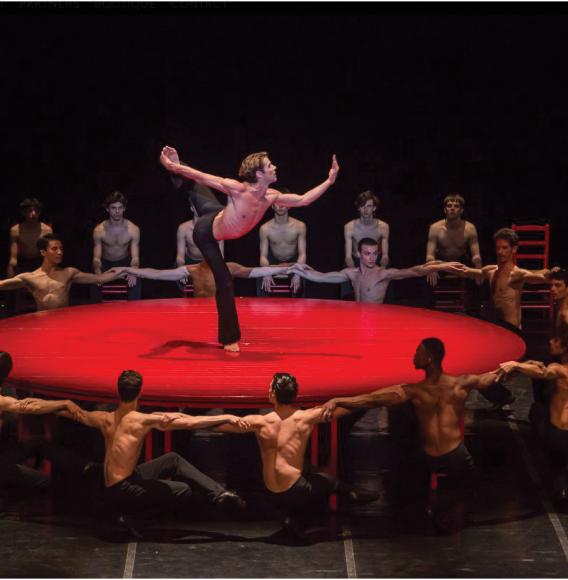It begins unexpectedly: A jazz pianist riffs on one of the most famous flute openings in musical history. But soon the percussion establishes the equally familiar beat — as inexorable as sexual desire — and we’re off in familiar territory.
And yet not so. Quarantined student dancers slink down stairs like cats, partner brooms and crumple on rumpled beds, motioning you to come hither as they burst forth into a cherry blossomed New York spring that will not be denied.
Famous alumni defiantly don red lipstick. Look, there’s Patti Lupone wagmag.com/patti-lupone-perennial-star/ and Christine Baranski. And Laura Linney brushing her teeth. Bebe Neuwirth shimmies in a hallway. Itzhak Perlman fiddles and communes with children and a dog. Yo-Yo Ma saws and soars away.
Meanwhile, faculty members hold phone meetings as their young children climb over them, and a conductor holds it all together as string, woodwind, brass and percussion players multiply on the screen.
The music drives everyone on, with dancers propelled outside to leap amid greenery and concrete. The climax comes as the brass instruments take us to new heights, a new place, and a garage door opens on a burst of light — freedom. As the music and images collapse on themselves, the screen goes dark except for two words — “Bolero Juilliard.”
The nine-and-a-half-minute piece — one of the most extraordinary we’ve seen in a long time — is Juilliard’s video interpretation youtube.com/watch?v=rqzkn-jX-JU of Maurice Ravel’s “Boléro” (1928), which the Manhattan performing arts conservatory created this past spring at the height of the pandemic in New York.
“What can we do together that we can’t do alone?” Damian Woetzel, president of Juilliard, wagmag.com/moving-still/ asked himself in imagining the work. “This is a question we take to heart as artists and as an institution. Right now, in this particular moment, we’re asking what can we do together even while we are alone. To answer this, I asked my friend the choreographer Larry Keigwin to create a new spin on his ‘Bolero’ project, which he has tailor-made into different productions for different communities over the past few years.”
The result is a triumphant response to the coronavirus — a victory of life in the face of death, freedom in the face of confinement, humor in the face of grief and creative courage in the face of paralyzing fear.
It’s also a stunning reminder that art still matters, perhaps more so in times of crisis. With theaters, concert halls and opera houses shuttered for the foreseeable future and museums only recently returned with strict protocols in place, art institutions have unleashed their ingenuity on the internet while even those with only a tangential relationship to any art form have started coloring, crafting, painting, sculpting, journaling and dusting off musical instruments. The arts have become a lifeline, an escape and a way to explain the inexplicable to ourselves. (Writers, including Yours Truly, thegamesmenplay.com/the-glass-door have begun publishing pandemic stories. Look for a spate of pandemic novels in the near future.)
But the arts have always sought to find meaning in tragedy. Pablo Picasso’s “Guernica,” a 1937 oil on canvas in Spain’s Museo Reina Sofia, used the dismemberment and disorientation of Cubism — the segmentation and deconstruction of the body — to capture the actual physical destruction of life and limb that resulted from the Nazi bombing that spring of the titular Basque town in support of Spain’s Fascist leader, Gen. Francisco Franco. (Later in Nazi-occupied Paris, a German officer would visit Picasso’s studio and see a postcard of the work. “Did you do this?” the officer asked. “No,” Picasso replied, “you did.”)
Life dictates, man adjusts and art responds. In the case of “Boléro,” Ravel was responding to a commission by the dancer Ida Rubinstein to orchestrate a few pieces from Isaac Albéniz’s piano work “Iberia” for a new ballet. Running into a copyright issue, Ravel ultimately decided to compose a new piece with only two themes and one underlying rhythm whose variety would come from his use of the orchestra. (While some experts have suggested that the repetition in “Boléro” reflected the dementia that would end Ravel’s career and his life, his brilliance as an orchestrator was such that it’s not surprising he set himself this challenge. (For an example of his orchestrating abilities, listen to his work on Modest Mussorgsky’s 1874 piano suite “Pictures at an Exhibition.”)
“Boléro” was an immediate hit, though the choreography by Bronislava Nijinska (Vaslav Nijinsky’s sister), which involved an enticing female dancer on a tabletop, is lost to us.
The music, however, would transcend its classical roots. Say “Boléro” and many think of Bo Derek, Venus in cornrows, rising from the sea in Blake Edward’s “10” (1979). (It was not Hollywood’s first pas de deux with “Boléro.” A 1934 film of the same title, about the onstage, offstage relationship of two dance partners showed George Raft to be more than an actor who specialized in gangsters. There’s also “The Bolero,” an exciting 1973 Oscar-winning short of conductor Zubin Mehta and the Los Angeles Philharmonic preparing to perform the piece.)
“Boléro” returned to its dance roots with Maurice Béjart’s 1960 ballet of the same name, which reflected the original work — a woman on a tabletop, this time surrounded only by men, who leap on the table as she, they and the music collapse. When feminists complained about the objectification of the woman in the piece, the story goes, Béjart turned the gender tables to feature a man in red surrounded by women.
But by far, his most successful — and controversial — iteration of the work showcased his muse, Jorge Donn, dancing on a red table clad only in black pants and encircled by a similarly clad group of male dancers. We saw it at Manhattan’s City Center Theater in 1983 and were more than amused by the audience’s reaction — the women on their feet, whooping and hollering; the men, seated, speechless. Seeing the ballet again on YouTube — it has been recreated many times with star ballerinas and danseurs, though Donn remains its greatest interpreter youtube.com/watch?v=m5CFJlzlGKM — you are reminded not only of its hypnotic, robotic, homomoerotic power but that dance began as religious ritual performed only by men.
Béjart’s “Bolero” may not replace Bo Derek in many minds but in others it comes more than pretty damn close.
“Bolero Juilliard” is available digitally on the Juilliard website, YouTube and IGTV.





